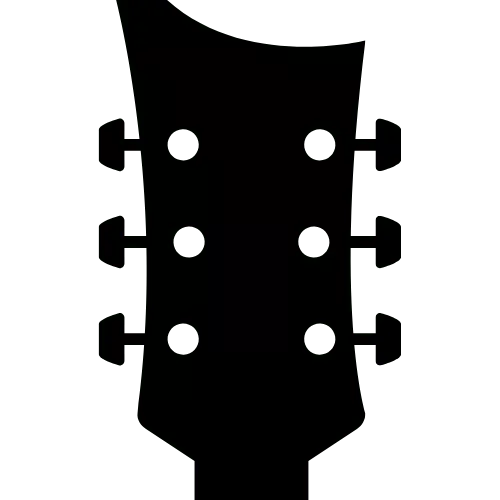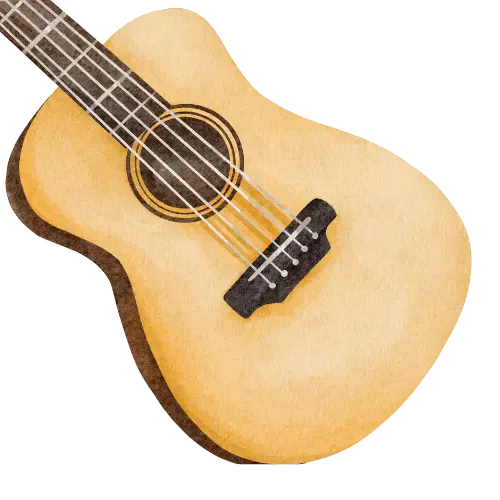Acoustic guitar is an interesting sounding instrument and quite enjoyable to play. But, you need to get a good acoustic guitar to utilize the true gravity of the instrument. To choose a good acoustic guitar first you need to have a clear idea of the different parts of the instrument.
Apart from that, learning the guitar anatomy is the very first lesson you will receive. To help you out, in this article we will introduce the different parts of an acoustic guitar and take you one step closer to your instrument.
Three Main Parts of an Acoustic Guitar
There are many types of acoustic guitar that might have different parts. But, any acoustic guitar is divided into three main parts. They are –
- Hadstock
- Neck
- Body
The following discussion covers each of these parts and their respective sections from top to bottom.
Headstock

The area at the top of the neck is known as the headstock or the head. One end of the guitar strings are attached to the headstock where you can adjust the string tension to tune the guitar. Depending on the manufacturer and model, headstocks can be straight or inclined and have a variety of shapes.
Headstock has the following parts –
- Capstan
- Tuning Pegs
- Nut
Capstan (String Post, Tuning Post)
Capstans are the parts of the machine head (tuning mechanism) that hold the strings properly in place. They rise perpendicular to the head as you can see.
Tuning Pegs (Tuning Keys, Tuners, Tuning Heads)
By winding the string around the capstan using a pinion gear and a worm gear, tuners or machine heads can raise or lower the pitch by adjusting the string’s tension. They are normally composed of metal and can be arranged three on each side of the head (for example, on a Les Paul) or all six on one side (for example, on a Fender Stratocaster).
Nut

The notched white strip known as the nut is in charge of seating the strings as they traverse from the headstock to the neck of the guitar. The nut’s slits are essential for maintaining the string height and for keeping the string in line with the fretboard. In a beginner’s guitar, it is typically made of molded plastic or corian, whereas a higher-grade guitar has a nut made of bone, brass, or graphite.
Neck

The guitar’s neck is the length of thin wood that extends from the headstock to the body. You hold the guitar with your fingers on the fretboard in front of the neck and your thumb on the back of the neck. An acoustic guitar neck has the following parts –
- Fredboards
- Frets
- Position Marker
- Truss Rod
Fredboards (Finger Board)
Notes are played by pressing the strings against the fingerboard. Their typical materials are rosewood or maple, with maple typically producing a brighter sound. The fingerboard, which you directly touch, is a crucial component of the instrument in terms of feel and sound.
Frets
The numerous little metal strips that span the entire fretboard are known as frets. To produce a different note, you press the strings behind each fret on the fretboard. To help produce a variety of notes, the frets on a guitar are spaced very accurately. 19 to 24 frets are common on acoustic guitars.
Position Markers (Inlays)
For the player’s benefit, the fretboard of guitars frequently has dots or other special markings inlaid into it. The third, fifth, seventh, ninth, twelfth, and fifteenth frets are often where these markers are located, with the twelfth fret (octave) frequently differing from the others (for instance, two dots instead of one).
Truss Rod
A steel or graphite metal rod known as a truss rod passes through the neck slightly below the fretboard. The neck is strengthened by this metal rod. The strings put a lot of strain on the neck, causing it to bend, when tuning or playing the guitar. The truss rod aids in preventing neck bending.
Body

This is the guitar’s largest section. The sound travels through the hole and reverberates inside the resonance chamber. The guitar’s tone is greatly influenced by the type of wood used, as well as by the instrument’s design and craftsmanship. If the body is properly constructed, it can also amplify sound by causing the entire guitar to vibrate in a way that produces a pleasing sound.
An acoustic guitar body has the following parts –
- Cutaway
- Sound Hole
- Pickguard
- Bridge
- Bridge Pins
- Saddle
Cutaway
To enable the musician to access the higher frets on their guitar, a cutaway is a curve in the guitar body at the base of the neck. However, some acoustic guitars lack the cutaway section called the dreadnought guitar.
Sound Hole
The sound hole on an acoustic guitar is a hole on the top of the guitar or on the sounding board. Its purpose is to magnify the sounds produced by strumming the guitar.
Rosetta
The rosette is the beautiful pattern placed around the sound hole. Builders will utilize the design to help trademark their various guitar lines, which can be plain or ornate.
Pickguard
The guitar pick guard or scratch plate does precisely what its name implies. it protects the soundboard from being scratched or damaged by a pick. Pick guards are available in a variety of materials, including mother of pearl or pearloid, plastic, metal, acrylic, and exotic woods. They are incredibly thin in order to reduce soundboard vibration.
Bridge
This is the point at which the strings come to an end and anchor to the body. Vibrations generated by play are transferred to the body via the bridge to produce tones. Bridges can be composed of a single material, commonly wood for acoustic guitars, or they can be formed of many materials, including plastic or bone.
Bridge Pins
Bridge pins are commonly used on steel string guitars to accurately set the string on the bridge. They are typically composed of wood, bone, or synthetic materials. The material chosen influences the tone of the guitar, causing it to lean either the bass or the treble.
Saddle
The saddle rests on the bridge. Like the nut, the saddle is the only other point of contact for the strings. They assist in holding the strings at a specific height and transmitting string vibrations via the bridge to the body of the instrument. The saddles of an acoustic guitar are a strip of plastic or bone.
Strings
You might begin to wonder if we forgot to discuss the strings. But, since the acoustic guitar strings go through all the three main parts (Head, Neck, & Body) of the instrument, we decided to introduce it at the end.
The strings are the most important part of a guitar because strumming or picking the strings produces the sounds. Strings are available in a variety of thicknesses and materials. Steel strings, For example, steel, bronze, or brass strings are used in acoustic guitars. The lower the pitch produced by the string, the thicker it is.
A guitar has six strings with varying thicknesses. While holding a guitar on your thighs, the strings go from thickest to thinnest from top to bottom. Strings are numbered sequentially up from the thinnest string, which is the first string, to the thickest string, which is the sixth string. From the sixth to the first string, the strings are also labeled E, A, D, G, B, and E.
Final Words
These are the most typical components of an acoustic guitar. They all contribute to the distinctive tone of the guitar. However, you now understand what each component performs and how to access them.
Hopefully, you found this article to be extremely useful and helpful in getting to know your guitar better. Thanks for reading this far.

